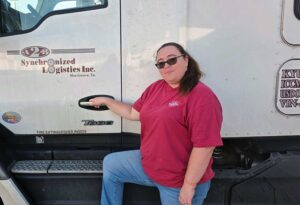We’ve all heard this second part of an old nursery rhyme:
What are little girls made of?
What are little girls made of?
Sugar and spice
And everything nice,
That’s what little girls are made of.
Let’s throw out that stereotype and start fresh.
Because although women make up around 50 percent of the population, they make up only just shy of 7 percent of truck drivers — 5-6 percent if we’re talking owner-operators says OOIDA — and far too few women hold board and management positions at trucking carriers and other trucking-related businesses.
It’s not that trucking hasn’t made great strides in bringing women into the industry.
After all, professional women drivers who were industry pioneers remember when there were no restroom facilities for women and women truckers were an anomaly on the road.
Goldie Seymour, National Carrier Inc.’s 2014 Driver of the Year and their first woman to earn the title, said, “When I first started, females didn’t drive. You just didn’t see women on the road” as truck drivers. “I can remember when you took a shower, you had to make someone stand guard because the showers were in the men’s restrooms.”
Women drivers also had to put up with lewd comments on the CB and were told to go back to the kitchen where they belonged.
So trucking has come a long way, baby. But there’s still a long way to go, and it can’t happen soon enough with truck turnover at 95 percent or higher for large carriers and 84 percent or higher for small truckload carriers. Not to mention that the American Trucking Associations is pegging the driver shortage at 50,000 with the potential to rise to 174,000 by 2024.
“Granted, we have to do better at attracting women to the industry,” said David Heller, the Truckload Carriers Association’s vice president of legislative affairs.
“But we might as well ask where are all the drivers, period, as where are all the women drivers,” he said. “There’s no magic bullet.”
Part of it is “overcoming stereotypes, I think. You talk about drivers and you’re just used to saying he or him, not she or her; you catch yourself. The question of where all the drivers are is now gender neutral.
“It’s a whole new horizon for our industry,” he said, adding that perhaps the same things that attract younger drivers, such as technology-laden truck cabs and more creature comforts, will attract more women as well.
The biggest reason more women aren’t in the industry is that trucking’s image is still that of an all-male job, said Ellen Voie, president and CEO of Women In Trucking (WIT) and herself a CDL holder. “Women just don’t look at the industry as being for them. They see a truck and don’t know anything about it. There’s no connection between that gallon of milk and the driver on the road.”
Trucking’s got to do a better job with that, Voie said, and toward that end she’s come up with a series of dolls dressed in uniforms depicting various trucking-related jobs and not surprisingly, a truck driver is the first one to be presented this spring.
You’ll hear many in the trucking industry talking about a “culture of safety.”
What about creating a culture that attracts and retains females — drivers, dock workers and middle and senior level administrators? A. Duie Pyle Chief Operating Officer Randy Swart, said the LTL carrier, which also offers specialized truckload services through their brokerage and TL solutions, hasn’t focused on hiring women, per se.
But, “It’s more that of a culture. Our culture and processes in general have resulted in that.”
The thing is, he added, is that Pyle promotes people of both sexes from within and gives them the training and opportunity to move up the corporate ladder.
Specifically, he said, the carrier recognizes “discretionary effort,” that is, employees who go above and beyond the norm. These men and women aren’t forced out of a job they love but are given the opportunity and training to move up if they choose.
Having women in leadership and visible helps drivers see women at the top who would understand them, said Voie.
In WIT’s constantly updated index of publicly traded companies, some carriers have no women in leadership or on their boards, which Voie said she found “amazing” in this day and age.
As Swart mentioned, however, not all women drivers want to move up the corporate ladder. What attracts them to trucking is what attracts many of their male counterparts: They want the freedom of the open road and they want a good, reliable paycheck.
Your average female driver is already in her 50s, Voie noted. “A lot of them don’t want an office position; they love being on the road.”
Women want the same things as men, really, said Garner Trucking President and CEO Sherri Garner Brumbaugh: More home time and time with their children.
Since women are usually the designated care-giver when it comes to children, it becomes a juggling act. Garner Trucking, Inc. has answered that problem by offering both men and women drivers four days home and four days on the road.
More frequently, she added, male drivers want more time with their children, and it’s “hard to argue with that.”
The most successful driver, male or female, has to have a strong support system at home, Brumbaugh noted.
With a woman driver, “the spouse has to be comfortable with the wife out driving a truck” she said. Research by the U.S. Department of Labor has found that the younger the children at home, the greater the challenge of the mother working away from home. Take the days and weeks truck drivers spend on the road and the problem for female drivers multiplies exponentially.
Truck driver Deb Bosworth, a charter member of WIT said: “Women say, ‘I couldn’t do that,’ and I say, ‘sure you could. You just need the right training. But if you want to be home every night, it’s probably not for you.’”
Do women need to be trained differently than men?
No, but they appreciate having a woman trainer and they also want a mentor. That’s what a Best Practices Survey commissioned for WIT found out.
The Trucker News Staff produces engaging content for not only TheTrucker.com, but also The Trucker Newspaper, which has been serving the trucking industry for more than 30 years. With a focus on drivers, the Trucker News Staff aims to provide relevant, objective content pertaining to the trucking segment of the transportation industry. The Trucker News Staff is based in Little Rock, Arkansas.















